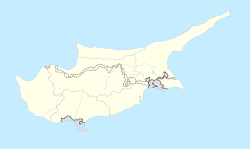| Λάπαθος, 𐤋𐤐𐤔 | |
 A coins of ṢDQMLK, King of Lapathus A coins of ṢDQMLK, King of Lapathus | |
 | |
| Location | Cyprus |
|---|---|
| Coordinates | 35°21′19″N 33°11′52″E / 35.355404°N 33.197851°E / 35.355404; 33.197851 |
Lapathus (Phoenician: 𐤋𐤐𐤔, romanized: LPŠ; Ancient Greek: Λάπαθος, Lápathos), also recorded as Lapethus (Λάπηθος, Lápēthos), Lepethis (Ληπηθίς, Lēpēthís), and Lapithus (Λάπιθος, Lápithos), was an ancient Cypriot, Phoenician and Greek town near present-day Lampousa and Karavas.
Name
Due to lack of evidence, researchers had not been sure weather the Phoenician name of the city was LPṬ (with Teth) or LPT (with Taw); recent findings, such as inscriptions and coins with legends, provide the clear reading LPŠ. The Greek and the Phoenician name record, each in its own way, a phoneme of a language prior to them both.
History

The foundation of Lapathus was credited to the Phoenician Kitians. Nonnus claimed the name derived from an eponymous Lapathus, a follower of Dionysus. Strabo said that it received a Spartan colony headed by Praxander. He adds that it was situated opposite to the town of Nagidus in Cilicia and possessed a harbour and docks. It was situated in the north of the island, on a river of the same name and in a district called Lapethia (Λαπηθία, Lapēthía).

The coins of the city from the 5th and 4th canturies BC record rulers of the city, in Phoenician: DMWNKS the first, ṢDQMLK, ʾNDR... (shorted name), and DMWNKS the second. The coins of the first two depicted the head of Athena, and the coins of the last two depicted Athena standing and Heracles.
In the war between Ptolemy and Antigonus, Lapathus and its king Praxippus sided with the latter.
The name of the place became synonymous with stupidity.
See also
References
Citations
- Huss (1985), p. 569.
- ^ Strabo. Geographica. Vol. xiv. p.682. Page numbers refer to those of Isaac Casaubon's edition.
- Ptolemy. The Geography. Vol. 5.14.4.
- Pliny. Naturalis Historia. Vol. 5.31.
- Periplus of Pseudo-Scylax, p. 41.
- Hierocles. Synecdemus.
- Richard Talbert, ed. (2000). Barrington Atlas of the Greek and Roman World. Princeton University Press. p. 72, and directory notes accompanying. ISBN 978-0-691-03169-9.
- Lund University. Digital Atlas of the Roman Empire.
- Slouschz, Nahoum (1942). Thesaurus of Phoenician Inscriptions (in Hebrew). Dvir. p. 106.
- ^ Masson, Olivier; Sznycer, Maurice (1972). Recherches sur les Phéniciens à Chypre (in French). Librairie Droz. p. 99.
- Stephanus of Byzantium. Ethnica. Vol. s.v.
- Nonnus, Dionys. 13.447.
- Ptolemy. The Geography. Vol. 5.14.5.
- ^ Masson, Olivier; Sznycer, Maurice (1972). Recherches sur les Phéniciens à Chypre (in French). Librairie Droz. pp. 98–100.
- Diodorus Siculus. Bibliotheca historica (Historical Library). Vol. 19.59.
- Suda s.v. Λαπάθιοι.
Bibliography
- Huss, Werner (1985), Geschichte der Karthager, Munich: C.H. Beck, ISBN 9783406306549. (in German)
 This article incorporates text from a publication now in the public domain: Smith, William, ed. (1854–1857). "Lapathus". Dictionary of Greek and Roman Geography. London: John Murray.
This article incorporates text from a publication now in the public domain: Smith, William, ed. (1854–1857). "Lapathus". Dictionary of Greek and Roman Geography. London: John Murray.
| Algeria |
|
|---|---|
| Cyprus | |
| Greece | |
| Israel | |
| Italy | |
| Lebanon | |
| Libya | |
| Malta |
|
| Morocco | |
| Portugal |
|
| Spain | |
| Syria | |
| Tunisia | |
| Other | |
This article about Cypriot history is a stub. You can help Misplaced Pages by expanding it. |